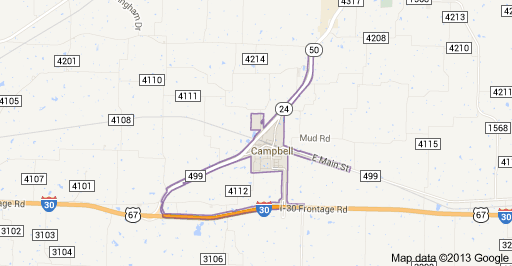|
Campbell, Texas
Campbell is a mile north of Interstate Highway 30 and six miles east of Greenville in eastern Hunt County. Settlement began at the site in the fall of 1880, when the long-awaited East Line and Red River Railroad was extended from Black Jack Grove to Greenville. The town was built around the railroad, and a station was constructed. A post office was established in June 1881, and the community was officially named Oliverea. By fall of that year, however, the town was generally referred to as Campbell or sometimes Tom Campbell, perhaps in honor of Thomas M. Campbell, later governor of Texas, who had played a prominent part in the extension of the railroad. At least one source contends that the Tom Campbell for whom the town was named was not the governor, since the community was established before Governor Campbell became prominent. The name of the post office was officially changed to Campbell in September 1882.
Campbell became a shipping center for area farmers and by 1900 had a population of 508 and twelve businesses, as well as a college, Henry College, founded in 1892. Although the town lost its college in 1906, when Emerson College, the successor of Henry College, was forced to close, Campbell's population remained stable. The town was incorporated in 1912 with an aldermanic form of government. Between 1920, when the population was 583, and 1925, the small farming community experienced a burst of growth. By 1925 Campbell had a telephone exchange, a bank, power and light services, a weekly newspaper, twenty commercial establishments, and an estimated population of 1,000. By 1930 there were only twelve businesses remaining, and the population had fallen to 416. Although the population remained stable thereafter until the early 1960s, the number of businesses continued to decline. By 1936 the bank had closed, and by the early 1950s only seven businesses remained. In 1961 only four were still open. The population reached a low of 204 in 1970. In the mid-1980s, when Campbell had six businesses, the town was reincorporated to take in part of the surrounding rural area; consequently, the population jumped to 549. In 1990 it was 683, and in 2000 it was 734.
BIBLIOGRAPHY: W. Walworth Harrison, History of Greenville and Hunt County, Texas (Waco: Texian, 1976). Fred I. Massengill, Texas Towns: Origin of Name and Location of Each of the 2,148 Post Offices in Texas (Terrell, Texas, 1936). Thomas Clarence Richardson, East Texas: Its History and Its Makers (4 vols., New York: Lewis Historical Publishing, 1940).
Emerson College, in Campbell, Hunt County, was established in September 1903 as a private, coeducational institution designed to offer a four-year college program. The school operated for three years. In April B. F. Holcomb, S. W. Miller, J. R. Johnson, and a number of Campbell residents purchased the old Henry College campus from Henry T. Bridges. In September 1903 they opened Emerson College, named for Ralph Waldo Emerson. The institution's facilities consisted of at least an administration-classroom building and dormitories. It maintained music, art, commercial, primary, and liberal arts departments aimed to "train the youth for duties incumbent upon them as citizens of the Republic, as factors of the social structure." Instruction was offered leading to four degrees: bachelor of arts, bachelor of science, bachelor of literature, and licentiate of instruction. Thirty-six courses were required for a degree. An unexpectedly large initial enrollment of 500 students almost overwhelmed the faculty, administration, and facilities of the new school. Such interest also encouraged the owners to borrow money with which to expand the college. On the heels of this beginning, however, drought and crop failure hit Northeast Texas in 1904 and 1905, ruining the area's economy, substantially reducing Emerson College's enrollment, and decreasing the tuition and fees collected. This reduction of income, which made repayment of the loans impossible, combined with the competition for students provided by such other Hunt County colleges as East Texas Normal College (now East Texas State University) at Commerce and Texas Holiness University at Peniel, forced the institution to close in June 1906.
BIBLIOGRAPHY:
Jackson Massey, A History of College Education in Hunt County, Texas (M.A. thesis, University of Texas, 1928). Donald W. Whisenhunt, The Encyclopedia of Texas Colleges and Universities (Austin: Eakin, 1986).

Map of Campbell
Back to Cities & Towns page
|

